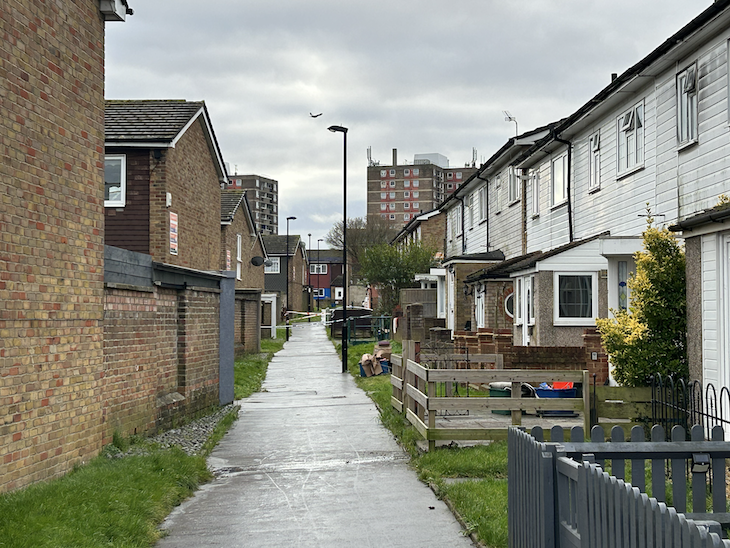There’s blood spattered on the pavement but locals in New Addington, an estate in Croydon, southeast London, seem curiously unbothered. ‘I’ve had no problems,’ Eli, who lives around the corner from the latest stabbing, tells me.
Eli’s house is close to Rowdown Field, where last March a human head and other dismembered body parts were found. Sarah Mayhew, a 38-year-old mother of two, was murdered and her remains dumped here. Flowers and solar-powered candles are pinned to the side of a metal cargo container in the car park visited by her killer. Leftover police tape flutters in the wind. The roar of traffic from the main road shatters the silence.
Diana, who lives nearby, is afraid. ‘It makes me feel worried,’ she says. ‘You had the murder down there and now this stabbing. What can you do? I’d like to move but I can’t. I’m stuck here. You just have to get on with it and do your best, but it’s not great’.
Peter, who has lived on the estate for 55 years, is also troubled. ‘It’s getting a bit close to home,’ he says.
At the very edge of London, New Addington is the last link on the green belt around the city. It’s a strange place. The estate rises on a steep hill at the start of the North Downs. From its summit, the lights of the Shard 14 miles away twinkle at night. Out here, London feels a long way away.
New Addington is surrounded by fields and farmland, but it’s not a place where you’d choose to live. Those who do shut themselves away at night for fear of what might be happening on their doorstep.
Much of the violence in New Addington is concentrated around Fieldway, a mile-long road that snakes its way through the most deprived part of the estate.
In December, two brothers were jailed for murdering a man and nearly killing his brother in a double stabbing in a cul-de-sac off Fieldway. A tree festooned with boxing gloves serves as a tribute to Bradley Hutchins, the teenager who lost his life in that attack.
That murder in 2023 happened only a few hundred feet from a notorious child killing in 2012. Twelve-year-old schoolgirl Tia Sharp was murdered by her grandmother’s partner who sexually assaulted her and stashed her body in the loft; it took police a week to find her remains.
The house where Tia’s life was snuffed out has been demolished. An identical property, with a different number, has been put in its place. The horror of what unfolded there continues to haunt neighbours.
‘My daughter used to play with Tia. It’s awful. The memory stays with you of what happened in that house,’ a lady who lives close to the house tells me. Another neighbour, Carole, 71, who has lived on the estate for 50 years, says New Addington is getting worse.
Violence is just part of the problem. The estate is a magnet for fly tippers. Mounds of rubbish are piled up by the roadside. In November, Croydon was named as having one of the worst fly-tipping problems in the whole country.
The CR0 postcode, covering New Addington, has another dubious honour: it has the highest headcount of XL Bully dogs in the UK. Several local residents I spoke to said that these animals – and other oversized dogs – are a daily worry. Dogs and knives are part of the armoury of the gangs who plague this estate.
New Addington is a place where locals look out for one another. Its strong sense of community is striking in London, but this comes from solidarity in the face of danger rather than any joy of living here. It’s a place where you keep an eye out for your neighbour but learn to turn a blind eye to criminals.
When the sun goes down, New Addington’s maze of alleyways and shortcuts take on a new life. Field Boyz, loosely named after the road, are one of Croydon’s most notorious gangs. They see this patch as theirs. The misery of the estate is a useful recruiting tool for the gangs who offer a route to riches that seem otherwise unobtainable. Residents worry about their teenagers whom they fear might be lured in.
New Addington’s notoriety is hardly new. I grew up a mile or so away in the 1990s; back then, the area was already perceived as a ghetto with a troubled reputation. As the journalist Robert Chesshyre has pointed out, those who built the estate in the 1950s and 1960s had little hope for the community from the outset: New Addington had a farm to train up labourers – nicknamed ‘Cowshit College’ – rather than a grammar school.
Chesshyre came in for some flak when he described New Addington as ‘benighted’ following the murder of Tia Sharp in 2012. A decade on, it’s still hard not to reach for that word.
‘It is what it is,’ one man tells me. ‘We moved from Dorset and I would go back in a heartbeat, but this is the only place close to our family where we can afford to live.’

Part of New Addington’s problem is its isolation. There is one road in and one road out. When you set out on foot from New Addington, you appreciate how cut off it is. It’s a place you need a car to escape from.
The Croydon Tramlink, which opened in 2000, was meant to address this problem. But while it makes it easier to leave, the tram brings its own problems: its route bisects turf belonging to different gangs who protect their postcodes with extraordinary violence. Even in a capital with a growing knife problem, Croydon has a reputation as a problem patch. In 2021, more teenage murders happened here than in any other part of London. In 2023, it had one of the highest murder rates in the capital.
Locals are afraid of crossing the gangs. One man who did, father-of-three Gary Hayward, who was not a member of a gang, was left blind in one eye after being savagely beaten by a group of youths armed with metal poles and baseball bats in New Addington’s Central Parade in 2011. Fourteen years on, and despite various police appeals and the offer of a reward of tens of thousands of pounds, no one has been brought to justice for that attack. It seems implausible that within this close-knit estate people don’t know who was responsible. His mother, Wendie Hayward, tells me: ‘Gary was in a coma for 18 months and has effectively lost his life. He will never be able to work again. He will never be able to live alone. Meanwhile, the yobs who were responsible are able to just get on with their lives’.
Wendie, who knows the name of at least one of the attackers – a prolific local criminal – says that while witnesses did come forward, they were warned about the repercussions of speaking to the police. They chose to keep quiet.
Another unsolved attack linked to New Addington was the gunning down of a football club manager in 2009. Ryan Musgrove suffered wounds to his heart, kidneys, and spleen after being shot six times at Sparrows Den Playing Fields in West Wickham, Bromley. The gunman, who was wearing a mask and skiing goggles, fled on a bicycle across fields in the direction of New Addington. He has never been caught. New Addington’s residents know when it’s wise to say nothing.








Comments